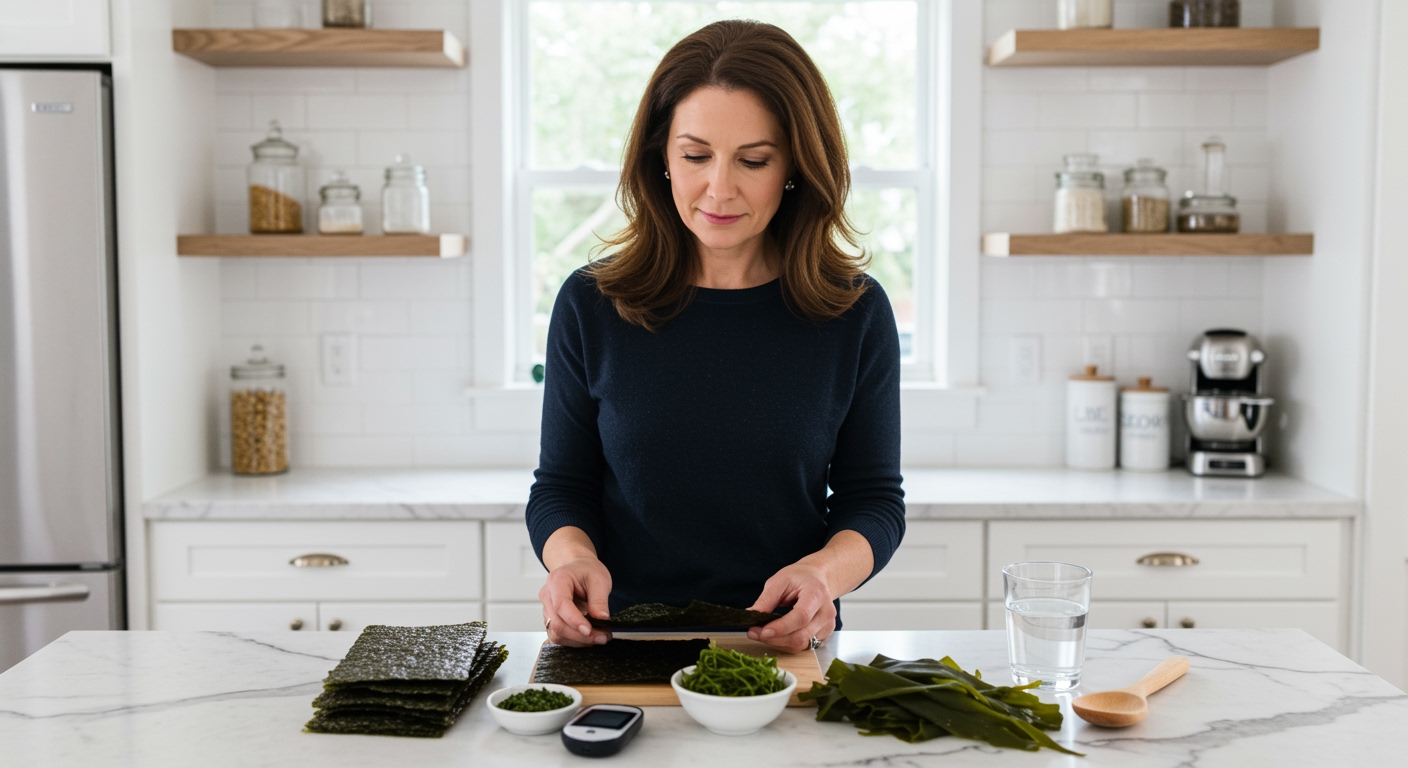✪ Key Takeaway: Seaweed is excellent for diabetes due to its high fiber content and natural compounds that help regulate blood sugar levels.
Introduction
You walk down the grocery store aisle and spot those mysterious dark green sheets in the international section.
Maybe you are wondering if this ocean vegetable could actually help manage your blood sugar levels instead of spiking them like so many other foods seem to do.
Hi, I am Abdur, your nutrition coach and today I am going to explain exactly how seaweed affects your diabetes and why it might become your new favorite superfood.
What Makes Seaweed Special For Blood Sugar Control?
Seaweed contains a unique type of soluble fiber called alginate that acts like a sponge in your digestive system.
This fiber forms a gel-like substance when it meets water in your stomach.
The gel slows down the absorption of glucose from your meals into your bloodstream.
Think of it as a natural speed bump for sugar rushing into your blood.
Research shows that people who eat seaweed regularly have more stable blood sugar levels throughout the day.
The mineral content in seaweed also plays a crucial role in glucose metabolism.
Chromium and magnesium found in sea vegetables help your cells respond better to insulin.
✪ Fact: Just one sheet of nori seaweed contains more fiber than a slice of whole wheat bread.
How Does Seaweed Compare To Other Diabetes Foods?
Most diabetes-friendly foods focus on being low in carbohydrates or high in protein.
Seaweed takes a different approach by actively blocking sugar absorption rather than just avoiding it.
While a cup of brown rice has about 45 grams of carbohydrates, the same amount of seaweed has less than 10 grams.
But the real magic happens when you eat seaweed with other foods.
Studies show that adding seaweed to a meal can reduce the glycemic impact of that entire meal by up to 30 percent.
This means your blood sugar will rise more slowly and stay more stable even when you eat foods that normally cause spikes.
Unlike many processed diabetes foods that taste bland, seaweed adds a rich umami flavor that makes healthy eating more enjoyable.
✪ Pro Tip: Add a small piece of kombu seaweed to your rice while cooking to reduce its glycemic impact naturally.
Which Types Of Seaweed Work Best For Diabetes?
Not all seaweed varieties offer the same benefits for blood sugar control.
Brown seaweeds like kelp, kombu, and wakame contain the highest levels of alginate fiber.
These varieties also have more chromium and other trace minerals that support insulin sensitivity.
Nori, the seaweed used in sushi, has less fiber but provides excellent protein content for its size.
Dulse and sea lettuce offer moderate benefits and work well as salad additions.
Fresh seaweed typically contains more active compounds than dried versions, but dried seaweed is more convenient and has a longer shelf life.
The key is choosing seaweed that has been minimally processed without added sugars or artificial preservatives.
✪ Note: Always rinse dried seaweed before eating to remove excess sodium that could affect blood pressure.
Are There Any Risks With Eating Seaweed For Diabetes?
Seaweed is generally safe for people with diabetes, but there are some important considerations.
The biggest concern is iodine content, especially in brown seaweeds like kelp.
Too much iodine can interfere with thyroid function, which is already a concern for many people with diabetes.
Stick to moderate portions of about one to two sheets of nori or a tablespoon of other seaweed varieties per day.
Some seaweed products are high in sodium, which can affect blood pressure.
If you take blood-thinning medications, talk to your doctor before adding large amounts of seaweed to your diet.
Seaweed contains natural compounds that can have mild anticoagulant effects.
✪ Pro Tip: Start with small amounts and monitor your blood sugar response to find your optimal seaweed intake.
How Should You Add Seaweed To Your Diabetes Diet?
The easiest way to start is by adding nori sheets to your meals as a wrap or side dish.
You can wrap vegetables, lean protein, or even use it as a replacement for bread in sandwiches.
Wakame seaweed works perfectly in soups and salads, adding both nutrition and flavor.
Try adding a small piece of kombu to your cooking water when preparing rice or beans.
This technique not only reduces the glycemic impact of these foods but also adds minerals.
Seaweed snacks can replace chips or crackers when you need something crunchy.
The key is to eat seaweed with meals rather than alone to maximize its blood sugar benefits.
✪ Fact: Eating seaweed 15 minutes before a meal can enhance its blood sugar stabilizing effects.
The Bottom Line
Seaweed is not just safe for diabetes but can be a powerful tool in your blood sugar management strategy.
The ocean gives us foods that work with our bodies, not against them, and seaweed proves this beautifully by naturally slowing sugar absorption while providing essential nutrients.
I would love to hear about your experience with seaweed or any questions you might have about incorporating it into your diabetes diet, so please share your thoughts in the comments below.
References
At NutritionCrown, we use quality and credible sources to ensure our content is accurate and trustworthy. Below are the sources referenced in creating this article:





